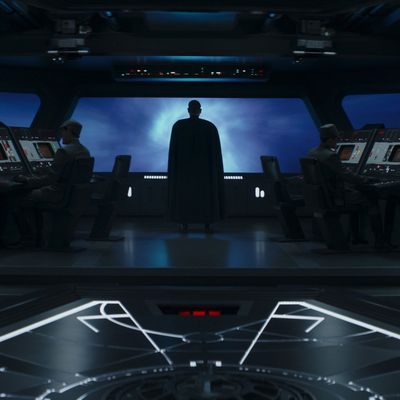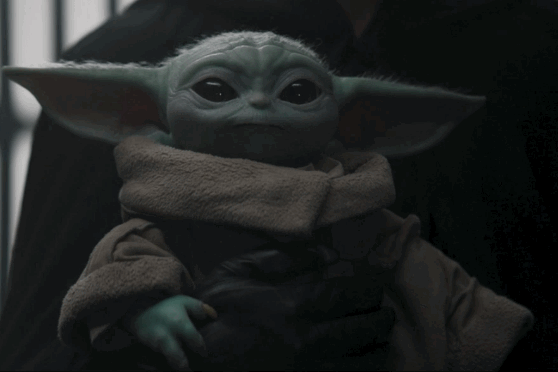
FYI: This piece will be rife with Mandalorian season-two finale spoilers.
In the eighth and final episode of The Mandalorian’s second season, as Mando and his coterie of Imperial Cruiser intruders fight Moff Gideon and attempt to rescue Grogu, a starfighter suddenly appears.
“Great, one X-wing,” quips Cara Dune quips. “We’re saved.”
Actually, they are saved. When the pilot of said X-wing disembarks, he proceeds to lightsaber his way through every robo-protector in Moff Gideon’s army. His face remains shrouded under a hood, protecting his identity, but the fact that Grogu is so energized by this figure’s presence strongly hints at who it might be. That is confirmed when he reaches Mando and Grogu, removes his hood, and reveals himself to be Luke Skywalker, looking as young, vibrant, and Force-filled as he did in Return of the Jedi.
If you’re a Star Wars fan and your heart didn’t grow three sizes, at least, during this moment, check your pulse. The idea that Luke should be the one to rescue Grogu, making Baby Yoda the student of the Jedi who once was the student of Actual Yoda, is such a lovely idea and one that should have been obvious — in retrospect, of course this was going to happen! — yet somehow wasn’t, and therefore landed as a poignant surprise.
The return of this particular Jedi is a perfect example of what Star Wars, as a franchise, often tries to do and only occasionally succeeds at: marrying a sense of nostalgia with the telling of compelling new stories. In its films, it has had mixed success with this. (I contend that it did this exactly right in The Force Awakens, and if you’d like to fight me on this, you can find me on Twitter.) But in The Mandalorian, particularly this season, it has done this very well, leaning into preexisting characters and mythology at appropriate, well-chosen moments.
The reintroduction of Boba Fett in The Mandalorian, first in “The Marshal,” and more fully in “The Tragedy,” stayed true to the lore the fans have always built around the OG bounty hunter — that despite being a bad guy, he’s a total badass — while adding more dimension to his character and backstory than he ever had in the original trilogy. The fact that he was played by Temuera Morrison, who played Jango Fett, the “father” from whom Boba was cloned, in the Star Wars prequels was another nod back to the history of this massive sci-fi saga.
Given the finale’s post-credits scene, where Boba and Fennec Shand pay a less-than-friendly visit to Bib Fortuna, still under the extremely wrong impression that Boba died in a Sarlacc pit, we’re going to be learning plenty more about him. A closing teaser notes that The Book of Boba Fett will be coming to Disney+ in December 2021, a reminder that, as wonderful as these hat tips back to the old days of Star Wars are, they also play right into the Disney strategy of strip-mining beloved pop culture from our childhoods for the sake of more revenue.
Even if the corporate savviness beneath The Mandalorian’s actions is pretty obvious, remarkably, that doesn’t render its callbacks and heartfelt touches any less effective. Grogu has been the breakout star of The Mandalorian since the very beginning, precisely because he was both a callback and something fresh. The fact that he was immediately dubbed Baby Yoda was a testament to that. And yes, of course, it helped that Grogu is insanely adorable and imminently GIF-able.
But as lovable as Grogu has been, the finale appearance of Luke Skywalker — played by Mark Hamill and de-aged by CGI to look the way Luke would have following the events of Episode VI — is easily the most touching moment in The Mandalorian so far. That’s because it brings this series, arguably the most universally appreciated mainstream Star Wars work since the films of the 1970s and early ’80s, full circle back to where it all started.
When Mando says good-bye to Grogu, a child to whom he has effectively been a father, it’s an echo of Yoda’s deathbed farewell to Luke in Return of the Jedi, when Yoda confirmed that Darth Vader was the young Skywalker’s father. When Luke picks up Grogu and leaves — accompanied by R2D2, because your heart wasn’t bursting enough — that imagery is a mirror of Luke and Yoda in The Empire Strikes Back. While being trained on Dagobah, Yoda sat in Luke’s backpack, looking over his shoulder from behind him. As Luke leaves with Grogu, he cradles The Child on his chest as Grogu gazes over Luke’s shoulder from the other side at a teary-eyed Mando.
Once again, Mando has removed his helmet in this final scene so that Grogu can see his eyes and touch his face. (Skin-on-skin contact: important for babies even on The Mandalorian.) It also makes the scene much more meaningful because we can see Pedro Pascal’s face and witness the depth of his feelings. As much as the appeal in all the Star Wars stories is about action, lightsaber battles, and pew! pew! gun fights — and there was plenty of pew! pew! in this season finale — it’s also about the strong feelings those stories elicit when they confirm that the thing you loved when you were little is still something worthy of love as an adult. The Mandalorian confirmed that repeatedly in season two. Our helmets have been removed, and our eyes are a little teary, because of that.
Update: An earlier version of this piece incorrectly referred to Return of the Jedi as Episode III, when it is of course Episode VI. It has been corrected.



